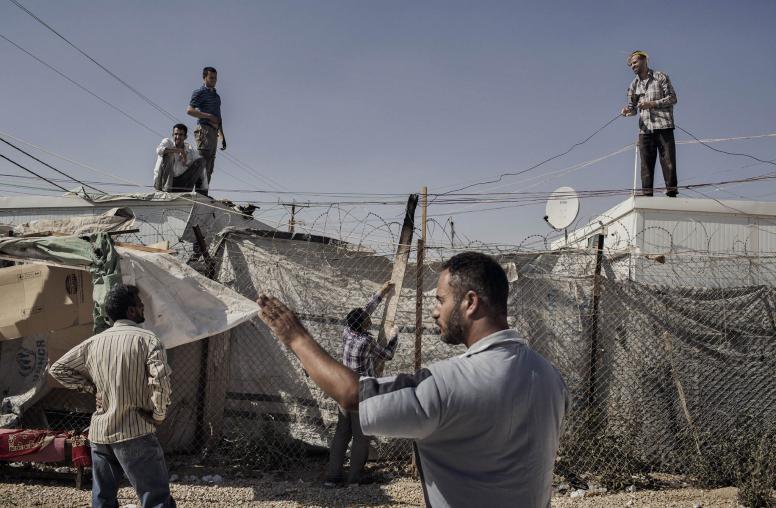Enormous Earthquakes Exacerbate Syria’s Humanitarian Crisis
Turkey and Syria both saw major damage. But Syria’s ongoing conflict complicates aid delivery to an already beleaguered population.
A powerful earthquake, registering 7.8 on the Richter scale, struck Turkey and Syria early Monday morning, with a 7.5 magnitude tremor and other aftershocks felt by countries around the region. Initial figures suggest that in Turkey as many as 2,921 were killed and 13,293 injured, with 5,600 buildings collapsed. All told, the death toll in Turkey and Syria stands at 4,300 but is likely to continue to rise. The epicenter of the quake was Turkey southern city of Gaziantep, home to nearly half a million Syrian refugees forced from their homeland amid Syria’s devastating civil war. While the international community mobilized quickly to pledge assistance, aid delivery to Syria — already dealing with massive humanitarian challenges in both rebel- and regime-held areas — will be particularly complicated given the country’s ongoing conflict.

USIP’s Mona Yacoubian explains how the earthquakes impact Syria, the prospects for and challenges to delivering international aid and the longer-term humanitarian implications for Syria.
How significant were the earthquakes’ impact inside Syria?
The earthquakes and continuing aftershocks — felt as far away as Lebanon, Iraq and Jordan, among other countries — have had a devastating impact on Syria. The death toll in Syria is 1,450, but is expected to rise significantly over the coming days. Towns in rebel-held northwest Syria, which is close to the quakes’ epicenter, witnessed massive devastation. Other areas of Syria including the cities of Aleppo, Lattakia and Hama recorded significant impacts, including lives lost and building collapses. The earthquake was felt as far as Qamishli and Raqqa in eastern Syria.
The temblor’s epicenter was in Gaziantep, Turkey, an area which serves as a key node for the delivery of humanitarian assistance to Syria given its proximity to the Syrian border. The United Nations, foreign governments and local and international NGOs all have offices in the region dedicated to addressing Syria’s longstanding humanitarian challenges. Their Syria operations will certainly be impacted as they contend with the earthquakes’ tragic effects on staff and area residents in Turkey.
What are the prospects for international aid following the quake?
Governments all over the globe have been responding with promises of aid to Turkey and Syria. President Joe Biden announced the immediate mobilization of search and rescue teams and assistance to Turkey and the provision of humanitarian aid to Syria through U.S.-supported partners. Gulf countries including the United Arab Emirates have also dispatched teams and aid to both countries. The Israeli military is reportedly providing search and rescue teams to Turkey, while Greece, Turkey longtime adversary, also offered support.
Access, however, remains a big challenge. Many roads are blocked given the widespread damage across southern Turkey and northwest Syria, impeding the ability to undertake rescues, assess damage or deliver aid. Provision of aid and search and rescue support to Syria is further complicated by the state of conflict. Access into rebel-held northwest Syria is limited to one specified U.N. humanitarian crossing at Bab al-Hawa; physical damage in the area and a complex monitoring system will undoubtedly slow the speed of assistance. Over the past few years, Russia has used its veto to cut in half the number of U.N. crossings — which must be approved through a U.N. Security Council vote — into northwest Syria (from two to one).
Access to regime-held Syria damaged in the earthquake is complicated by the Syrian regime’s poor relations with much of the international community. Long-term reconstruction of earthquake-damaged infrastructure in regime-held Syria will be even more complicated given formal prohibitions against such assistance by the United States, the United Kingdom and the European Union barring the establishment of a credible, substantive and genuine political process to resolve Syria’s nearly 12-year-long conflict.
What are the longer-term implications of the two earthquakes for the humanitarian situation inside Syria?
The massive earthquakes will further compound Syria’s already catastrophic humanitarian crisis. While levels of violence have somewhat abated, the humanitarian situation continues to deteriorate as the Syrian economy spirals downward. Last month the Syrian pound plummeted to a new low before a slight rebound, leading to higher inflation and growing poverty and food insecurity. The level of need in Syria is at the highest level since the outset of the conflict 12 years ago, according to the United Nations. The country is already contending with a serious cholera outbreak. Rebel-held northwest Syria — the most adversely impacted by the earthquake — is home to among the most vulnerable populations in Syria. Nearly all of the 4.5 million inhabitants of the area were already in need of humanitarian aid. Many residents of the area have been displaced multiple times throughout the course of the conflict, ending up in northwest Syria.
The earthquake’s devastating impacts will deepen humanitarian suffering in Syria, making longer-term recovery an even more distant prospect.


